
- Free Study Planner
- Residency Consulting
- Free Resources
- Med School Blog
- 1-888-427-7737

The Ultimate Patient Case Presentation Template for Med Students
- by Neelesh Bagrodia
- Apr 06, 2024
- Reviewed by: Amy Rontal, MD

Knowing how to deliver a patient presentation is one of the most important skills to learn on your journey to becoming a physician. After all, when you’re on a medical team, you’ll need to convey all the critical information about a patient in an organized manner without any gaps in knowledge transfer.
One big caveat: opinions about the correct way to present a patient are highly personal and everyone is slightly different. Additionally, there’s a lot of variation in presentations across specialties, and even for ICU vs floor patients.
My goal with this blog is to give you the most complete version of a patient presentation, so you can tailor your presentations to the preferences of your attending and team. So, think of what follows as a model for presenting any general patient.
Here’s a breakdown of what goes into the typical patient presentation.

7 Ingredients for a Patient Case Presentation Template
1. the one-liner.
The one-liner is a succinct sentence that primes your listeners to the patient.
A typical format is: “[Patient name] is a [age] year-old [gender] with past medical history of [X] presenting with [Y].
2. The Chief Complaint
This is a very brief statement of the patient’s complaint in their own words. A common pitfall is when medical students say that the patient had a chief complaint of some medical condition (like cholecystitis) and the attending asks if the patient really used that word!
An example might be, “Patient has chief complaint of difficulty breathing while walking.”
3. History of Present Illness (HPI)
The goal of the HPI is to illustrate the story of the patient’s complaint.
I remember when I first began medical school, I had a lot of trouble determining what was relevant and ended up giving a lot of extra details. Don’t worry if you have the same issue. With time, you’ll learn which details are important.
The OPQRST Framework
In the beginning of your clinical experience, a helpful framework to use is OPQRST:
Describe when the issue started, and if it occurs during certain environmental or personal exposures.
P rovocative
Report if there are any factors that make the pain better or worse. These can be broad, like noting their shortness of breath worsened when lying flat, or their symptoms resolved during rest.
Relay how the patient describes their pain or associated symptoms. For example, does the patient have a burning versus a pressure sensation? Are they feeling weakness, stiffness, or pain?
R egion/Location
Indicate where the pain is located and if it radiates anywhere.
Talk about how bad the pain is for the patient. Typically, a 0-10 pain scale is useful to provide some objective measure.
Discuss how long the pain lasts and how often it occurs.
A Case Study
While the OPQRST framework is great when starting out, it can be limiting.
Let’s take an example where the patient is not experiencing pain and comes in with altered mental status along with diffuse jaundice of the skin and a history of chronic liver disease. You will find that certain sections of OPQRST do not apply.
In this event, the HPI is still a story, but with a different framework. Try to go in chronological order. Include relevant details like if there have been any changes in medications, diet, or bowel movements.
Pertinent Positive and Negative Symptoms
Regardless of the framework you use, the name of the game is pertinent positive and negative symptoms the patient is experiencing.
I’d like to highlight the word “pertinent.” It’s less likely the patient’s chronic osteoarthritis and its management is related to their new onset shortness of breath, but it’s still important for knowing the patient’s complete medical picture. A better place to mention these details would be in the “Past Medical History” section, and reserve the HPI portion for more pertinent history.
As you become exposed to more illness scripts, experience will teach you which parts of the history are most helpful to state. Also, as you spend more time on the wards, you will pick up on which questions are relevant and important to ask during the patient interview.
By painting a clear picture with pertinent positives and negatives during your presentation, the history will guide what may be higher or lower on the differential diagnosis.
Some other important components to add are the patient’s additional past medical/surgical history, family history, social history, medications, allergies, and immunizations.
The HEADSSS Method
Particularly, the social history is an important time to describe the patient as a complete person and understand how their life story may affect their present condition.
One way of organizing the social history is the HEADSSS method:
– H ome living situation and relationships – E ducation and employment – A ctivities and hobbies – D rug use (alcohol, tobacco, cocaine, etc.) Note frequency of use, and if applicable, be sure to add which types of alcohol consumption (like beer versus hard liquor) and forms of drug use. – S exual history (partners, STI history, pregnancy plans) – S uicidality and depression – S piritual and religious history
Again, there’s a lot of variation in presenting social history, so just follow the lead of your team. For example, it’s not always necessary/relevant to obtain a sexual history, so use your judgment of the situation.
4. Review of Symptoms
Oftentimes, most elements of this section are embedded within the HPI. If there are any additional symptoms not mentioned in the HPI, it’s appropriate to state them here.
5. Objective
Vital signs.
Some attendings love to hear all five vital signs: temperature, blood pressure (mean arterial pressure if applicable), heart rate, respiratory rate, and oxygen saturation. Others are happy with “afebrile and vital signs stable.” Just find out their preference and stick to that.
Physical Exam
This is one of the most important parts of the patient presentation for any specialty. It paints a picture of how the patient looks and can guide acute management like in the case of a rigid abdomen. As discussed in the HPI section, typically you should report pertinent positives and negatives. When you’re starting out, your attending and team may prefer for you to report all findings as part of your learning.
For example, pulmonary exam findings can be reported as: “Regular chest appearance. No abnormalities on palpation. Lungs resonant to percussion. Clear to auscultation bilaterally without crackles, rhonchi, or wheezing.”
Typically, you want to report the physical exams in a head to toe format: General Appearance, Mental Status, Neurologic, Eyes/Ears/Nose/Mouth/Neck, Cardiovascular, Pulmonary, Breast, Abdominal, Genitourinary, Musculoskeletal, and Skin. Depending on the situation, additional exams can be incorporated as applicable.
Now comes reporting pertinent positive and negative labs. Several labs are often drawn upon admission. It’s easy to fall into the trap of reading off all the labs and losing everyone’s attention. Here are some pieces of advice:
You normally can’t go wrong sticking to abnormal lab values.
One qualification is that for a patient with concern for acute coronary syndrome, reporting a normal troponin is essential. Also, stating the normalization of previously abnormal lab values like liver enzymes is important.
Demonstrate trends in lab values.
A lab value is just a single point in time and does not paint the full picture. For example, a hemoglobin of 10g/dL in a patient at 15g/dL the previous day is a lot more concerning than a patient who has been stable at 10g/dL for a week.
Try to avoid editorializing in this section.
Save your analysis of the labs for the assessment section. Again, this can be a point of personal preference. In my experience, the team typically wants the raw objective data in this section.
This is also a good place to state the ins and outs of your patient (if applicable). In some patients, these metrics are strictly recorded and are typically reported as total fluid in and out over the past day followed by the net fluid balance. For example, “1L in, 2L out, net -1L over the past 24 hours.”
6. Diagnostics/Imaging
Next, you’ll want to review any important diagnostic tests and imaging. For example, describe how the EKG and echo look in a patient presenting with chest pain or the abdominal CT scan in a patient with right lower quadrant abdominal pain.
Try to provide your own interpretation to develop your skills and then include the final impression. Also, report if a diagnostic test is still pending.
7. Assessment/Plan
This is the fun part where you get to use your critical thinking (aka doctor) skills! For the scope of this blog, we’ll review a problem-based plan.
It’s helpful to begin with a summary statement that incorporates the one-liner, presenting issue(s)/diagnosis(es), and patient stability.
Then, go through all the problems relevant to the admission. You can impress your audience by casting a wide differential diagnosis and going through the elements of your patient presentation that support one diagnosis over another.
Following your assessment, try to suggest a management plan. In a patient with congestive heart failure exacerbation, initiating a diuresis regimen and measuring strict ins/outs are good starting points.
You may even suggest a follow-up on their latest ejection fraction with an echo and check if they’re on guideline-directed medical therapy. Again, with more time on the clinical wards you’ll start to pick up on what management plan to suggest.
One pointer is to talk about all relevant problems, not just the presenting issue. For example, a patient with diabetes may need to be put on a sliding scale insulin regimen or another patient may require physical/occupational therapy. Just try to stay organized and be comprehensive.
A Note About Patient Presentation Skills
When you’re doing your first patient presentations, it’s common to feel nervous. There may be a lot of “uhs” and “ums.”
Here’s the good news: you don’t have to be perfect! You just need to make a good faith attempt and keep on going with the presentation.
With time, your confidence will build. Practice your fluency in the mirror when you have a chance. No one was born knowing medicine and everyone has gone through the same stages of learning you are!
Practice your presentation a couple times before you present to the team if you have time. Pull a resident aside if they have the bandwidth to make sure you have all the information you need.
One big piece of advice: NEVER LIE. If you don’t know a specific detail, it’s okay to say, “I’m not sure, but I can look that up.” Someone on your team can usually retrieve the information while you continue on with your presentation.
Example Patient Case Presentation Template
Here’s a blank patient case presentation template that may come in handy. You can adapt it to best fit your needs.
Chief Complaint:
History of Present Illness:
Past Medical History:
Past Surgical History:
Family History:
Social History:
Medications:
Immunizations:
Vital Signs : Temp ___ BP ___ /___ HR ___ RR ___ O2 sat ___
Physical Exam:
General Appearance:
Mental Status:
Neurological:
Eyes, Ears, Nose, Mouth, and Neck:
Cardiovascular:
Genitourinary:
Musculoskeletal:
Most Recent Labs:

Previous Labs:
Diagnostics/Imaging:
Impression/Interpretation:
Assessment/Plan:
One-line summary:
#Problem 1:
Assessment:
#Problem 2:
Final Thoughts on Patient Presentations
I hope this post demystified the patient presentation for you. Be sure to stay organized in your delivery and be flexible with the specifications your team may provide.
Something I’d like to highlight is that you may need to tailor the presentation to the specialty you’re on. For example, on OB/GYN, it’s important to include a pregnancy history. Nonetheless, the aforementioned template should set you up for success from a broad overview perspective.
Stay tuned for my next post on how to give an ICU patient presentation. And if you’d like me to address any other topics in a blog, write to me at [email protected] !
Looking for more (free!) content to help you through clinical rotations? Check out these other posts from Blueprint tutors on the Med School blog:
- How I Balanced My Clinical Rotations with Shelf Exam Studying
- How (and Why) to Use a Qbank to Prepare for USMLE Step 2
- How to Study For Shelf Exams: A Tutor’s Guide
About the Author
Hailing from Phoenix, AZ, Neelesh is an enthusiastic, cheerful, and patient tutor. He is a fourth year medical student at the Keck School of Medicine of the University of Southern California and serves as president for the Class of 2024. He is applying to surgery programs for residency. He also graduated as valedictorian of his high school and the USC Viterbi School of Engineering, obtaining a B.S. in Biomedical Engineering in 2020. He discovered his penchant for teaching when he began tutoring his friends for the SAT and ACT in the summer of 2015 out of his living room. Outside of the academic sphere, Neelesh enjoys surfing at San Onofre Beach and hiking in the Santa Monica Mountains. Twitter: @NeeleshBagrodia LinkedIn: http://www.linkedin.com/in/neelesh-bagrodia

Related Posts

Our Top USMLE Tips & Tricks for IMGs Applying to US Residencies

How to Register for Your First USMLE as an IMG

Spot the Difference: DO vs. MD
Search the blog, try blueprint med school study planner.
Create a personalized study schedule in minutes for your upcoming USMLE, COMLEX, or Shelf exam. Try it out for FREE, forever!
Could You Benefit from Tutoring?
Sign up for a free consultation to get matched with an expert tutor who fits your board prep needs
Find Your Path in Medicine
A side by side comparison of specialties created by practicing physicians, for you!
Popular Posts

Need a personalized USMLE/COMLEX study plan?
- - Google Chrome
Intended for healthcare professionals
- Access provided by Google Indexer
- My email alerts
- BMA member login
- Username * Password * Forgot your log in details? Need to activate BMA Member Log In Log in via OpenAthens Log in via your institution

Search form
- Advanced search
- Search responses
- Search blogs
- Writing a case report...
Writing a case report in 10 steps
- Related content
- Peer review
- Victoria Stokes , foundation year 2 doctor, trauma and orthopaedics, Basildon Hospital ,
- Caroline Fertleman , paediatrics consultant, The Whittington Hospital NHS Trust
- victoria.stokes1{at}nhs.net
Victoria Stokes and Caroline Fertleman explain how to turn an interesting case or unusual presentation into an educational report
It is common practice in medicine that when we come across an interesting case with an unusual presentation or a surprise twist, we must tell the rest of the medical world. This is how we continue our lifelong learning and aid faster diagnosis and treatment for patients.
It usually falls to the junior to write up the case, so here are a few simple tips to get you started.
First steps
Begin by sitting down with your medical team to discuss the interesting aspects of the case and the learning points to highlight. Ideally, a registrar or middle grade will mentor you and give you guidance. Another junior doctor or medical student may also be keen to be involved. Allocate jobs to split the workload, set a deadline and work timeframe, and discuss the order in which the authors will be listed. All listed authors should contribute substantially, with the person doing most of the work put first and the guarantor (usually the most senior team member) at the end.
Getting consent
Gain permission and written consent to write up the case from the patient or parents, if your patient is a child, and keep a copy because you will need it later for submission to journals.
Information gathering
Gather all the information from the medical notes and the hospital’s electronic systems, including copies of blood results and imaging, as medical notes often disappear when the patient is discharged and are notoriously difficult to find again. Remember to anonymise the data according to your local hospital policy.
Write up the case emphasising the interesting points of the presentation, investigations leading to diagnosis, and management of the disease/pathology. Get input on the case from all members of the team, highlighting their involvement. Also include the prognosis of the patient, if known, as the reader will want to know the outcome.
Coming up with a title
Discuss a title with your supervisor and other members of the team, as this provides the focus for your article. The title should be concise and interesting but should also enable people to find it in medical literature search engines. Also think about how you will present your case study—for example, a poster presentation or scientific paper—and consider potential journals or conferences, as you may need to write in a particular style or format.
Background research
Research the disease/pathology that is the focus of your article and write a background paragraph or two, highlighting the relevance of your case report in relation to this. If you are struggling, seek the opinion of a specialist who may know of relevant articles or texts. Another good resource is your hospital library, where staff are often more than happy to help with literature searches.
How your case is different
Move on to explore how the case presented differently to the admitting team. Alternatively, if your report is focused on management, explore the difficulties the team came across and alternative options for treatment.
Finish by explaining why your case report adds to the medical literature and highlight any learning points.
Writing an abstract
The abstract should be no longer than 100-200 words and should highlight all your key points concisely. This can be harder than writing the full article and needs special care as it will be used to judge whether your case is accepted for presentation or publication.
Discuss with your supervisor or team about options for presenting or publishing your case report. At the very least, you should present your article locally within a departmental or team meeting or at a hospital grand round. Well done!
Competing interests: We have read and understood BMJ’s policy on declaration of interests and declare that we have no competing interests.

Researched by Consultants from Top-Tier Management Companies

Powerpoint Templates
Icon Bundle
Kpi Dashboard
Professional
Business Plans
Swot Analysis
Gantt Chart
Business Proposal
Marketing Plan
Project Management
Business Case
Business Model
Cyber Security
Business PPT
Digital Marketing
Digital Transformation
Human Resources
Product Management
Artificial Intelligence
Company Profile
Acknowledgement PPT
PPT Presentation
Reports Brochures
One Page Pitch
Interview PPT
All Categories
Top 7 Medical Case Presentation Templates with Samples and Examples
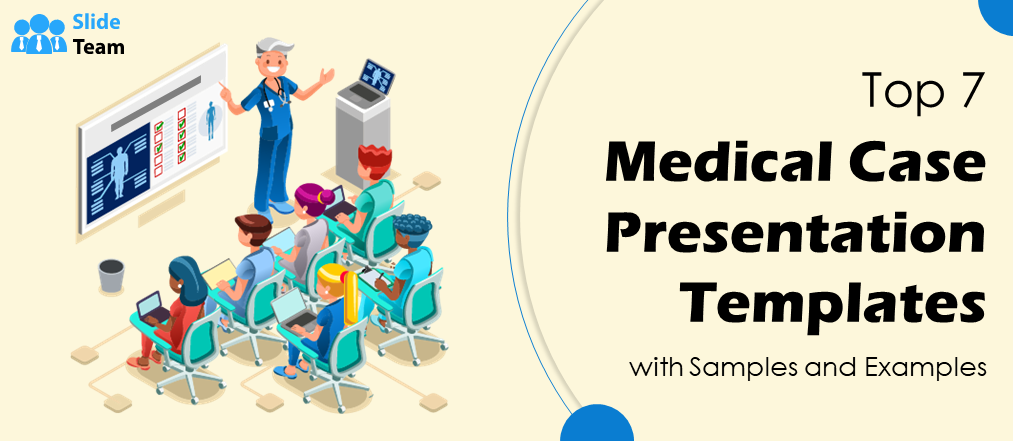
Sarojit Hazra
How does information expand beyond essential recollection? Facts alone can diminish in value over time. Context and implementation are crucial to form deep connections and roots. Here comes the role of case studies for clinical personnel in the medical field.
In the always-growing healthcare industry, medical case presentation is essential as it is a suggestion for new researchers. A medical case study is a report where a medical practitioner shares a patient's case. It comprises every detail related to patients. It is beneficial for describing a new medical condition, management options, or treatment for diseases.
Medical case presentations contribute significantly to the evolution of medical knowledge and research.
Case study analysis is essential for every business or industry, like the medical industry. It helps in managing the twists and turns of the industry. Want to take some ideas? Have a look at SlideTeam’s blog Case Analysis Templates .
Let us highlight some significant benefits of medical case presentation:
- Case study presentations are extremely good at depicting realistic clinical frameworks.
- It helps to enhance student participation alongside the joy of learning.
- These are ideal for sharing the latest information on the clinical landscape.
- It promotes critical thinking.
- It can also make better clinical outcomes.
If you are in the healthcare sector, another important tool is the medical dashboard. For a deeper insight, quickly take a look at Medical dashboard Templates .
Each of the slides is 100% editable and customizable. The 100% customizable nature of the templates allows you to edit your presentations. The content-ready slides give you the much-needed structure. Below, let’s explore a wide array of ready to use, content ready medical case presentation templates fit for your organization.
Template 1: Case Study on Blockchain Application in Healthcare: Medical Staff Credential Verification
Blockchain is becoming a potential solution to verify medical credentials. Though these are open to the public, they can be restricted through permissions. Are you finding it difficult to understand and implement? SlideTeam introduces this PPT Template that highlights how to operationalize medical staff verification process using blockchain technology. It explains that healthcare-based systems can also be used to verify the credentials of medical staff. Solutions-based blockchain to track the experiences of medical professionals. The PPT slides are designed with suitable icons, designs, graphs and other relevant material. Grab it quickly and draft your case study as per the client’s requirements.
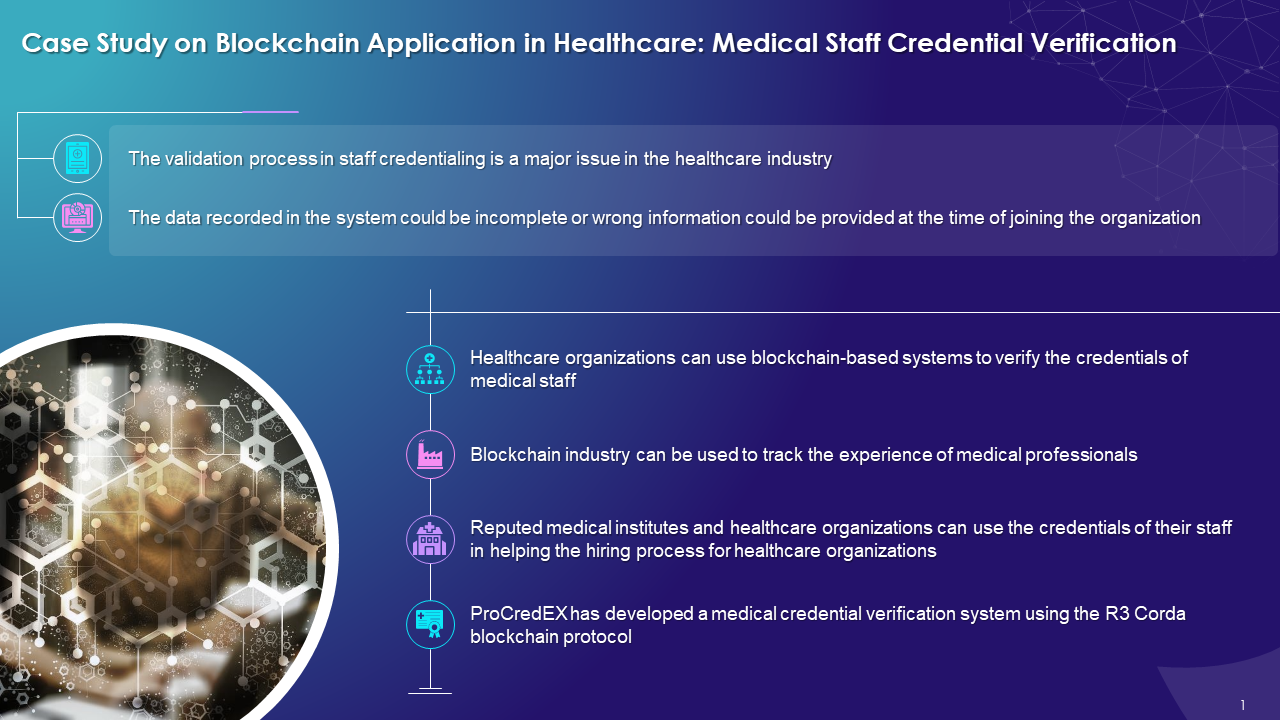
Click to Download
Template 2: Cost Benefits IOT Digital Twins Implementation Use Cases in the Medical Domain
This PPT template is designed to focus on the use cases in the medical domain, including research and development, diagnosis, surgery, medical equipment, etc. The slide offers a brief description of the mentioned use cases to understand the scenario better. Use it as an essential tool and captivate your audience. Get it Now!
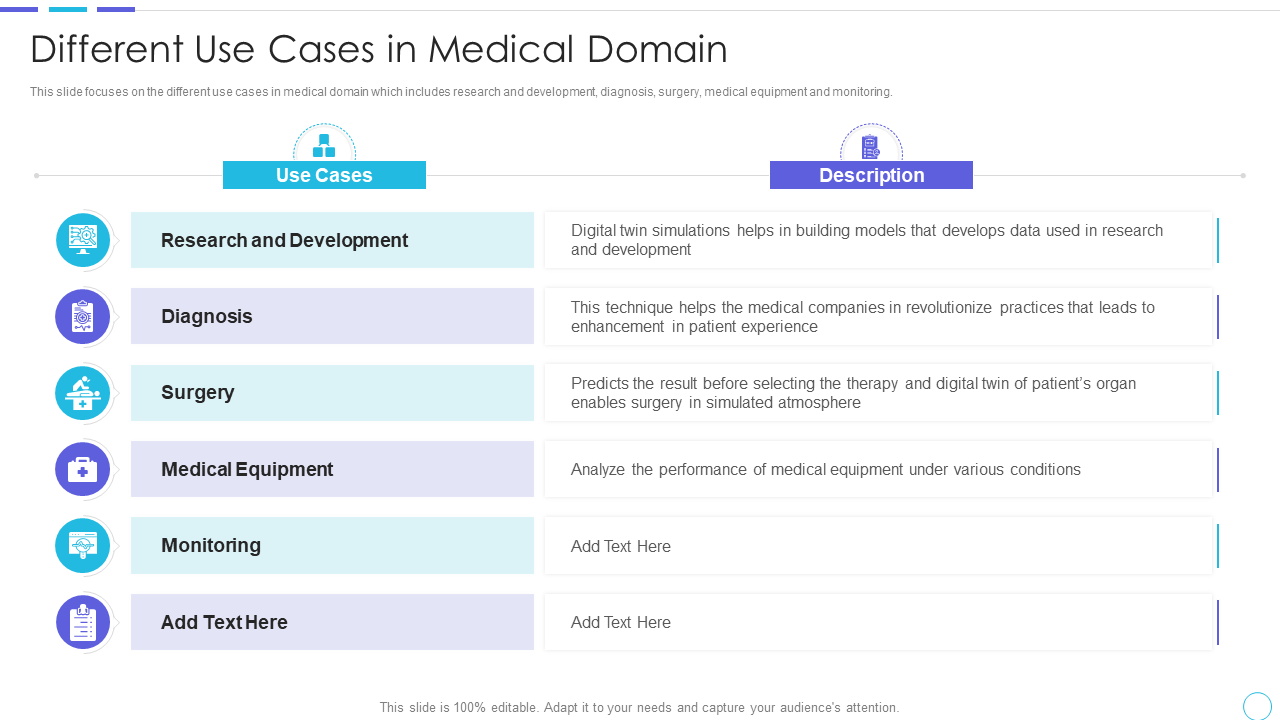
Template 3: Major Use Cases for Tracking Medical Assets Asset Tracking and Management IoT
Want to simplify medical complexities? The asset tracking solution is here to accompany you. It enables the medical sector to locate patients, clinicians, and medications more accurately and quickly. IoT development has made this task much more accessible by guiding you through every significant aspect of a medical asset-tracking solution. Introducing our slide exhibiting use cases of medical tools that can be tracked with IoT technology . Medical assets, including medical tools, medical equipment tracking, medications , etc., are shown in the layout with their use cases and impacts. Each topic is depicted in separate tables with appropriate icons.
Template 4: AIoT Healthcare Applications in Medical Imaging
AIoT is making the medical sector smarter and wiser to improve data management and human-machine interaction. When AIoT is applied to healthcare, enables virtual monitoring and accurate diagnosis of patients to develop a personalized patient experience. Here, we introduce our premium PPT Templates showcasing applications of Artificial Intelligence of Things (AIoT) in radiology. You can provide detailed information about remote diagnosis , personalized treatment , and real-time monitoring. Adapt it now to increase your presentation threshold and educate your audience.
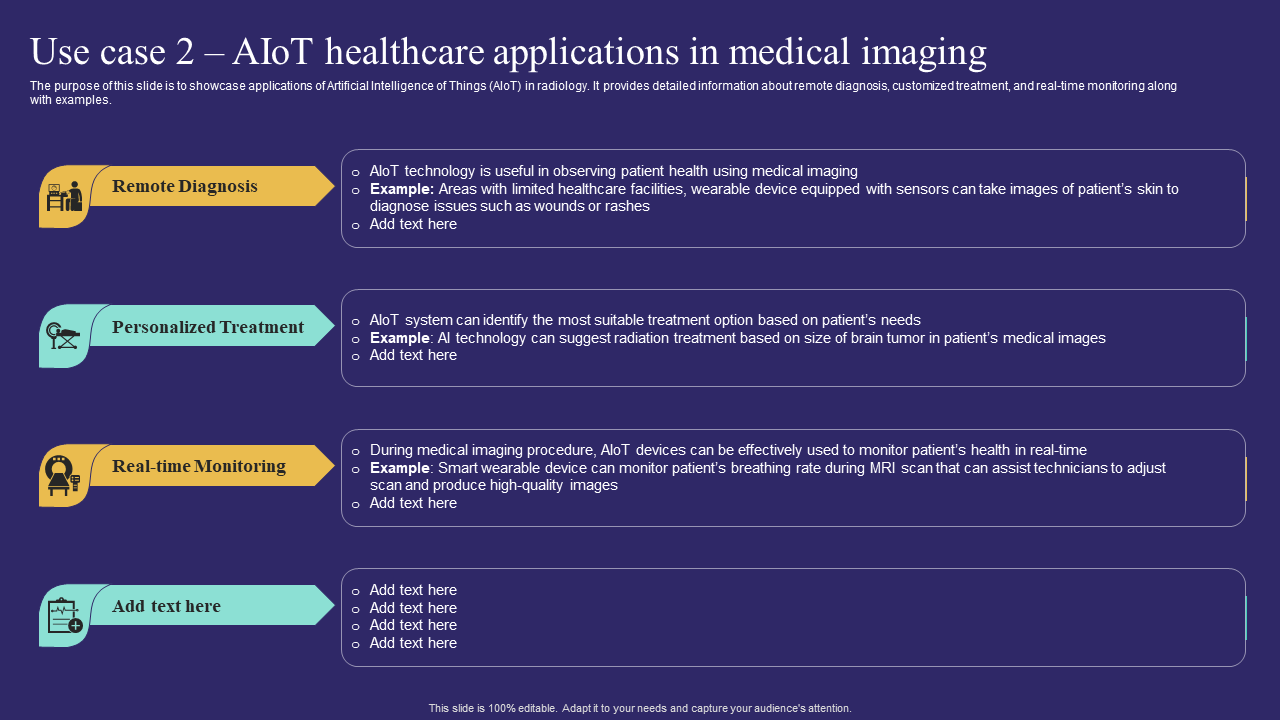
Template 5: Case Study of Leading Medical Devices Manufacturing Organization
An array of disruptive themes is shaping the medical device industry, and cloud computing is one of them. Soon, cloud computing will have a more significant impact on this industry. So, for your convenience, we are presenting our slide covering a case study of blue cloud with lending medical devices manufacturing organization. It covers significant topics like client objective, problem, our solution, and results chronologically. Consisting of three essential stages, this template is excellent for educating and enticing your audience.
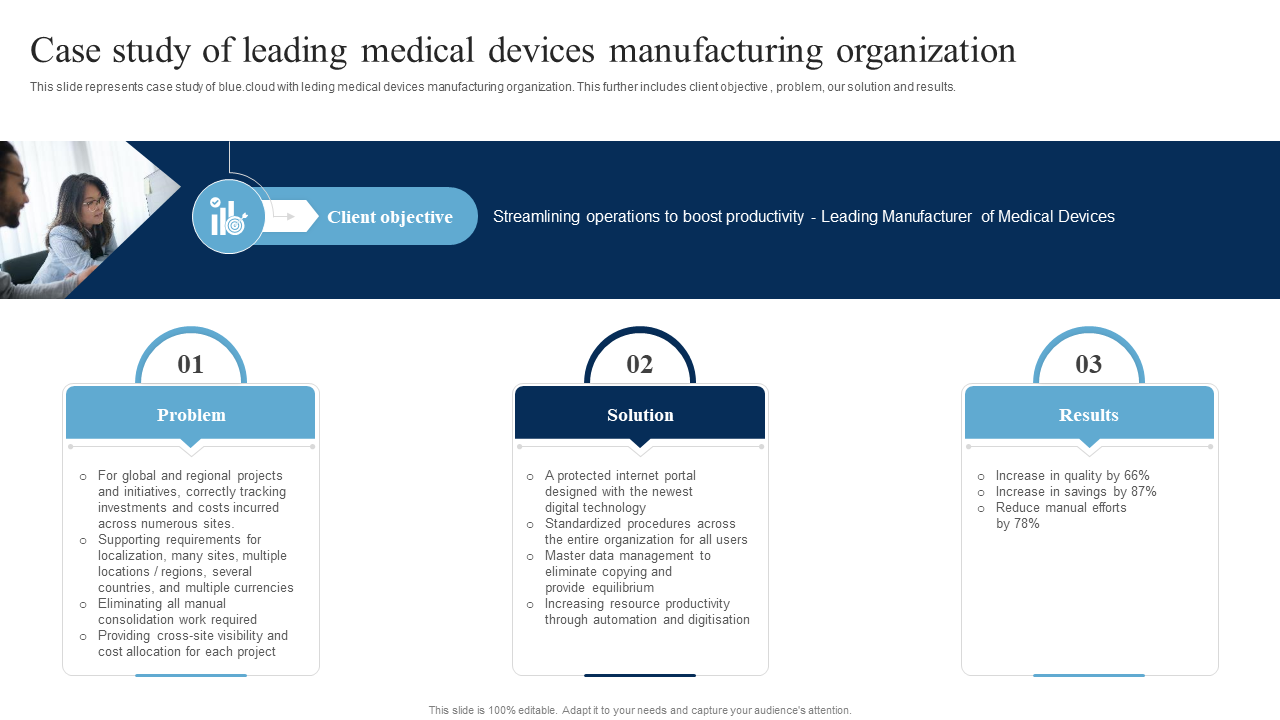
Template 6: IoT Technology Use Case for Medical Treatment
IoT, or the Internet of Things, is gaining significance across industries, and the medical sector is no exception. It has taken medical treatment to a new level. This custom-built PowerPoint Template exhibits the use of IoT technology in domains of the healthcare industry. It provides a digital solution for patient treatment. The key elements are primary care, acute care, virtual hospital, etc., which are depicted along with descriptions, benefits, and additional comments. Each illustration is highlighted, colored and has a relevant icon for instantaneous identification.
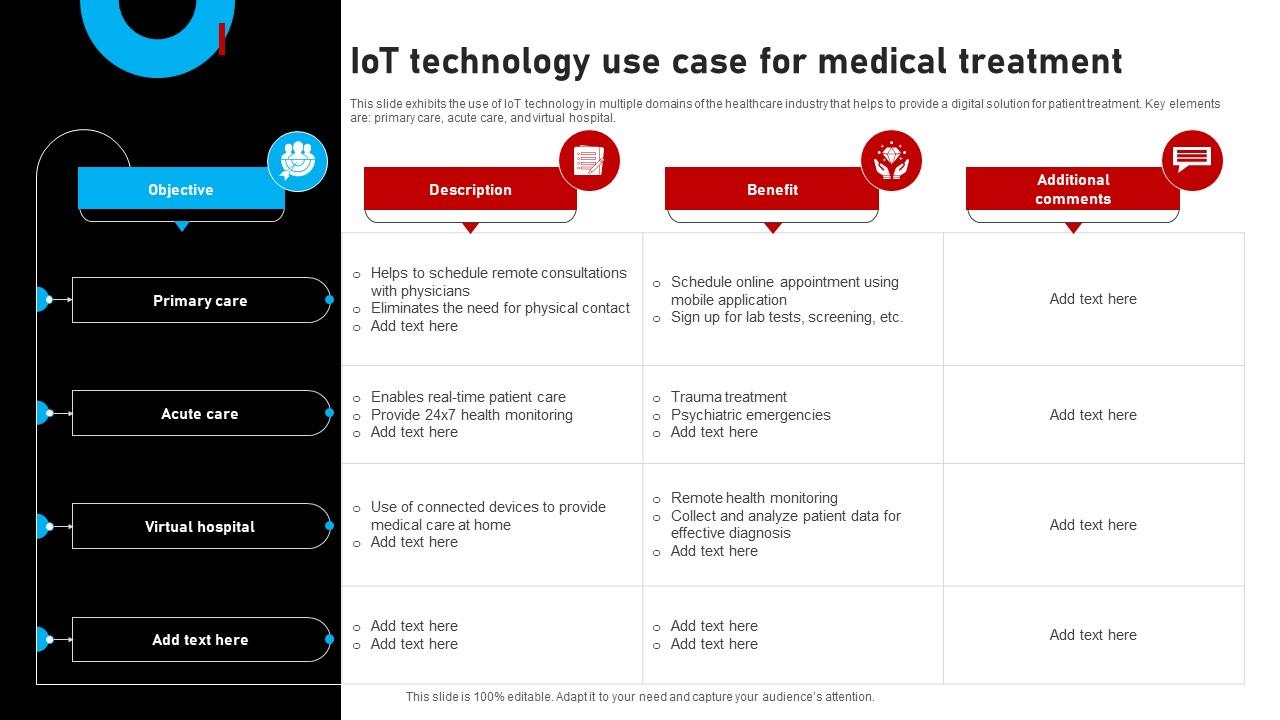
Template 7: IoT Medical Healthcare Technology Use Cases
The transformation of healthcare into digital healthcare has resulted in the rise of IoMT, or medical IoT . It refers to connected devices in medical healthcare and has become one of the fastest-growing industries in the IoT market. It would help if you dived deeper to manage, monitor, and preserve IoT devices in medical healthcare. This PPT presentation demonstrates uses of IoT Medical Healthcare Technology in monitoring patient health. Moreover, the slide includes remote patient monitoring, reduced waiting time, identifying chronic diseases, and drug management. Download this template design and present your case study with ultimate professionalism.
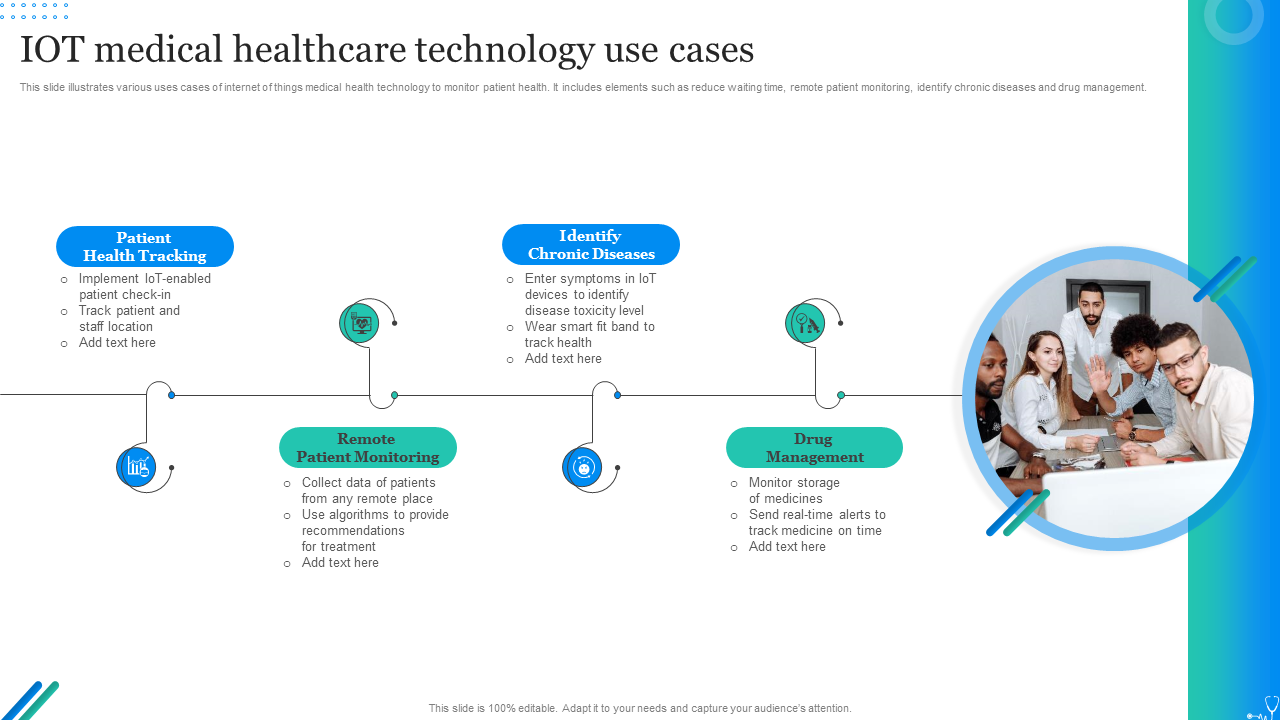
HEALTH CONSULTATION WILL BE QUICKER, SAFER AND SECURE
Case studies have a great history as an educational tool for clinicians. These are highly beneficial for nurturing deeper insights and learning. Access to such visually appealing and comprehensively presented Top 7 Medical Case Presentation Templates enables medical professionals to quickly present their patients' case studies. Be it tracking of medical assets, application of IoT in the clinical field, IoT medical healthcare technology uses, and so on, these templates serve as essential equipment in implementing all.
P.S. For perfection and success, you should dig into SlideTeam's fantastic blog, Medical Report Templates .
Related posts:
- How to Design the Perfect Service Launch Presentation [Custom Launch Deck Included]
- Quarterly Business Review Presentation: All the Essential Slides You Need in Your Deck
- [Updated 2023] How to Design The Perfect Product Launch Presentation [Best Templates Included]
- 99% of the Pitches Fail! Find Out What Makes Any Startup a Success
Liked this blog? Please recommend us

Top 10 Training Framework Templates with Examples and Samples

Top 5 Product Strategy Framework Templates with Samples and Examples
This form is protected by reCAPTCHA - the Google Privacy Policy and Terms of Service apply.

Digital revolution powerpoint presentation slides

Sales funnel results presentation layouts
3d men joinning circular jigsaw puzzles ppt graphics icons

Business Strategic Planning Template For Organizations Powerpoint Presentation Slides

Future plan powerpoint template slide

Project Management Team Powerpoint Presentation Slides

Brand marketing powerpoint presentation slides

Launching a new service powerpoint presentation with slides go to market

Agenda powerpoint slide show

Four key metrics donut chart with percentage

Engineering and technology ppt inspiration example introduction continuous process improvement

Meet our team representing in circular format

How to make an oral case presentation to healthcare colleagues
The content and delivery of a patient case for education and evidence-based care discussions in clinical practice.

BSIP SA / Alamy Stock Photo
A case presentation is a detailed narrative describing a specific problem experienced by one or more patients. Pharmacists usually focus on the medicines aspect , for example, where there is potential harm to a patient or proven benefit to the patient from medication, or where a medication error has occurred. Case presentations can be used as a pedagogical tool, as a method of appraising the presenter’s knowledge and as an opportunity for presenters to reflect on their clinical practice [1] .
The aim of an oral presentation is to disseminate information about a patient for the purpose of education, to update other members of the healthcare team on a patient’s progress, and to ensure the best, evidence-based care is being considered for their management.
Within a hospital, pharmacists are likely to present patients on a teaching or daily ward round or to a senior pharmacist or colleague for the purpose of asking advice on, for example, treatment options or complex drug-drug interactions, or for referral.
Content of a case presentation
As a general structure, an oral case presentation may be divided into three phases [2] :
- Reporting important patient information and clinical data;
- Analysing and synthesising identified issues (this is likely to include producing a list of these issues, generally termed a problem list);
- Managing the case by developing a therapeutic plan.

Specifically, the following information should be included [3] :
Patient and complaint details
Patient details: name, sex, age, ethnicity.
Presenting complaint: the reason the patient presented to the hospital (symptom/event).
History of presenting complaint: highlighting relevant events in chronological order, often presented as how many days ago they occurred. This should include prior admission to hospital for the same complaint.
Review of organ systems: listing positive or negative findings found from the doctor’s assessment that are relevant to the presenting complaint.
Past medical and surgical history
Social history: including occupation, exposures, smoking and alcohol history, and any recreational drug use.
Medication history, including any drug allergies: this should include any prescribed medicines, medicines purchased over-the-counter, any topical preparations used (including eye drops, nose drops, inhalers and nasal sprays) and any herbal or traditional remedies taken.
Sexual history: if this is relevant to the presenting complaint.
Details from a physical examination: this includes any relevant findings to the presenting complaint and should include relevant observations.
Laboratory investigation and imaging results: abnormal findings are presented.
Assessment: including differential diagnosis.
Plan: including any pharmaceutical care issues raised and how these should be resolved, ongoing management and discharge planning.
Any discrepancies between the current management of the patient’s conditions and evidence-based recommendations should be highlighted and reasons given for not adhering to evidence-based medicine ( see ‘Locating the evidence’ ).
Locating the evidence
The evidence base for the therapeutic options available should always be considered. There may be local guidance available within the hospital trust directing the management of the patient’s presenting condition. Pharmacists often contribute to the development of such guidelines, especially if medication is involved. If no local guidelines are available, the next step is to refer to national guidance. This is developed by a steering group of experts, for example, the British HIV Association or the National Institute for Health and Care Excellence . If the presenting condition is unusual or rare, for example, acute porphyria, and there are no local or national guidelines available, a literature search may help locate articles or case studies similar to the case.
Giving a case presentation
Currently, there are no available acknowledged guidelines or systematic descriptions of the structure, language and function of the oral case presentation [4] and therefore there is no standard on how the skills required to prepare or present a case are taught. Most individuals are introduced to this concept at undergraduate level and then build on their skills through practice-based learning.
A case presentation is a narrative of a patient’s care, so it is vital the presenter has familiarity with the patient, the case and its progression. The preparation for the presentation will depend on what information is to be included.
Generally, oral case presentations are brief and should be limited to 5–10 minutes. This may be extended if the case is being presented as part of an assessment compared with routine everyday working ( see ‘Case-based discussion’ ). The audience should be interested in what is being said so the presenter should maintain this engagement through eye contact, clear speech and enthusiasm for the case.
It is important to stick to the facts by presenting the case as a factual timeline and not describing how things should have happened instead. Importantly, the case should always be concluded and should include an outcome of the patient’s care [5] .
An example of an oral case presentation, given by a pharmacist to a doctor, is available here .
A successful oral case presentation allows the audience to garner the right amount of patient information in the most efficient way, enabling a clinically appropriate plan to be developed. The challenge lies with the fact that the content and delivery of this will vary depending on the service, and clinical and audience setting [3] . A practitioner with less experience may find understanding the balance between sufficient information and efficiency of communication difficult, but regular use of the oral case presentation tool will improve this skill.
Tailoring case presentations to your audience
Most case presentations are not tailored to a specific audience because the same type of information will usually need to be conveyed in each case.
However, case presentations can be adapted to meet the identified learning needs of the target audience, if required for training purposes. This method involves varying the content of the presentation or choosing specific cases to present that will help achieve a set of objectives [6] . For example, if a requirement to learn about the management of acute myocardial infarction has been identified by the target audience, then the presenter may identify a case from the cardiology ward to present to the group, as opposed to presenting a patient reviewed by that person during their normal working practice.
Alternatively, a presenter could focus on a particular condition within a case, which will dictate what information is included. For example, if a case on asthma is being presented, the focus may be on recent use of bronchodilator therapy, respiratory function tests (including peak expiratory flow rate), symptoms related to exacerbation of airways disease, anxiety levels, ability to talk in full sentences, triggers to worsening of symptoms, and recent exposure to allergens. These may not be considered relevant if presenting the case on an unrelated condition that the same patient has, for example, if this patient was admitted with a hip fracture and their asthma was well controlled.
Case-based discussion
The oral case presentation may also act as the basis of workplace-based assessment in the form of a case-based discussion. In the UK, this forms part of many healthcare professional bodies’ assessment of clinical practice, for example, medical professional colleges.
For pharmacists, a case-based discussion forms part of the Royal Pharmaceutical Society (RPS) Foundation and Advanced Practice assessments . Mastery of the oral case presentation skill could provide useful preparation for this assessment process.
A case-based discussion would include a pharmaceutical needs assessment, which involves identifying and prioritising pharmaceutical problems for a particular patient. Evidence-based guidelines relevant to the specific medical condition should be used to make treatment recommendations, and a plan to monitor the patient once therapy has started should be developed. Professionalism is an important aspect of case-based discussion — issues must be prioritised appropriately and ethical and legal frameworks must be referred to [7] . A case-based discussion would include broadly similar content to the oral case presentation, but would involve further questioning of the presenter by the assessor to determine the extent of the presenter’s knowledge of the specific case, condition and therapeutic strategies. The criteria used for assessment would depend on the level of practice of the presenter but, for pharmacists, this may include assessment against the RPS Foundation or Pharmacy Frameworks .
Acknowledgement
With thanks to Aamer Safdar for providing the script for the audio case presentation.
Reading this article counts towards your CPD
You can use the following forms to record your learning and action points from this article from Pharmaceutical Journal Publications.
Your CPD module results are stored against your account here at The Pharmaceutical Journal . You must be registered and logged into the site to do this. To review your module results, go to the ‘My Account’ tab and then ‘My CPD’.
Any training, learning or development activities that you undertake for CPD can also be recorded as evidence as part of your RPS Faculty practice-based portfolio when preparing for Faculty membership. To start your RPS Faculty journey today, access the portfolio and tools at www.rpharms.com/Faculty
If your learning was planned in advance, please click:
If your learning was spontaneous, please click:
[1] Onishi H. The role of case presentation for teaching and learning activities. Kaohsiung J Med Sci 2008;24:356–360. doi: 10.1016/s1607-551x(08)70132–3
[2] Edwards JC, Brannan JR, Burgess L et al . Case presentation format and clinical reasoning: a strategy for teaching medical students. Medical Teacher 1987;9:285–292. doi: 10.3109/01421598709034790
[3] Goldberg C. A practical guide to clinical medicine: overview and general information about oral presentation. 2009. University of California, San Diego. Available from: https://meded.ecsd.edu/clinicalmed.oral.htm (accessed 5 December 2015)
[4] Chan MY. The oral case presentation: toward a performance-based rhetorical model for teaching and learning. Medical Education Online 2015;20. doi: 10.3402/meo.v20.28565
[5] McGee S. Medicine student programs: oral presentation guidelines. Learning & Scholarly Technologies, University of Washington. Available from: https://catalyst.uw.edu/workspace/medsp/30311/202905 (accessed 7 December 2015)
[6] Hays R. Teaching and Learning in Clinical Settings. 2006;425. Oxford: Radcliffe Publishing Ltd.
[7] Royal Pharmaceutical Society. Tips for assessors for completing case-based discussions. 2015. Available from: http://www.rpharms.com/help/case_based_discussion.htm (accessed 30 December 2015)
You might also be interested in…


How to demonstrate empathy and compassion in a pharmacy setting
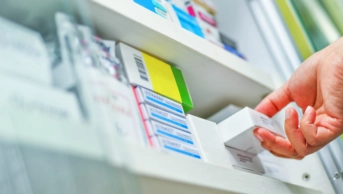
Be more proactive to convince medics, pharmacists urged

How pharmacists can encourage patient adherence to medicines
How to Write a Case Conceptualization: 10 Examples (+ PDF)

Such understanding can be developed by reading relevant records, meeting with clients face to face, and using assessments such as a mental status examination.
As you proceed, you are forming a guiding concept of who this client is, how they became who they are, and where their personal journey might be heading.
Such a guiding concept, which will shape any needed interventions, is called a case conceptualization, and we will examine various examples in this article.
Before you continue, we thought you might like to download our three Positive CBT Exercises for free . These science-based exercises will provide you with detailed insight into positive Cognitive-Behavioral Therapy (CBT) and give you the tools to apply it in your therapy or coaching.
This Article Contains:
What is a case conceptualization or formulation, 4 things to include in your case formulation, a helpful example & model, 3 samples of case formulations, 6 templates and worksheets for counselors, relevant resources from positivepsychology.com, a take-home message.
In psychology and related fields, a case conceptualization summarizes the key facts and findings from an evaluation to provide guidance for recommendations.
This is typically the evaluation of an individual, although you can extend the concept of case conceptualization to summarizing findings about a group or organization.
Based on the case conceptualization, recommendations can be made to improve a client’s self-care , mental status, job performance, etc (Sperry & Sperry, 2020).

- Summary of the client’s identifying information, referral questions, and timeline of important events or factors in their life . A timeline can be especially helpful in understanding how the client’s strengths and limitations have evolved.
- Statement of the client’s core strengths . Identifying core strengths in the client’s life should help guide any recommendations, including how strengths might be used to offset limitations.
- Statement concerning a client’s limitations or weaknesses . This will also help guide any recommendations. If a weakness is worth mentioning in a case conceptualization, it is worth writing a recommendation about it.
Note: As with mental status examinations , observations in this context concerning weaknesses are not value judgments, about whether the client is a good person, etc. The observations are clinical judgments meant to guide recommendations.
- A summary of how the strengths, limitations, and other key information about a client inform diagnosis and prognosis .
You should briefly clarify how you arrived at a given diagnosis. For example, why do you believe a personality disorder is primary, rather than a major depressive disorder?
Many clinicians provide diagnoses in formal psychiatric terms, per the International Classification of Diseases (ICD-10) or Diagnostic and Statistical Manual of Mental Disorders (DSM-5). Some clinicians will state a diagnosis in less formal terms that do not coincide exactly with ICD-10 or DSM-5 codes. What is arguably more important is that a diagnostic impression, formal or not, gives a clear sense of who the person is and the support they need to reach their goals.
Prognosis is a forecast about whether the client’s condition can be expected to improve, worsen, or remain stable. Prognosis can be difficult, as it often depends on unforeseeable factors. However, this should not keep you from offering a conservative opinion on a client’s expected course, provided treatment recommendations are followed.

Download 3 Free Positive CBT Exercises (PDF)
These detailed, science-based exercises will equip you or your clients with tools to find new pathways to reduce suffering and more effectively cope with life stressors.
Download 3 Free Positive CBT Tools Pack (PDF)
By filling out your name and email address below.
Based on the pointers for writing a case conceptualization above, an example for summarizing an adolescent case (in this instance, a counseling case for relieving depression and improving social skills) might read as follows.
Background and referral information
This is a 15-year-old Haitian–American youth, referred by his mother for concerns about self-isolation, depression, and poor social skills. He reportedly moved with his mother to the United States three years ago.
He reportedly misses his life and friends in Haiti. The mother states he has had difficulty adjusting socially in the United States, especially with peers. He has become increasingly self-isolating, appears sad and irritable, and has started to refuse to go to school.
His mother is very supportive and aware of his emotional–behavioral needs. The youth has been enrolled in a social skills group at school and has attended three sessions, with some reported benefit. He is agreeable to start individual counseling. He reportedly does well in school academically when he applies himself.
Limitations
Behavioral form completed by his mother shows elevated depression scale (T score = 80). There is a milder elevation on the inattention scale (T score = 60), which suggests depression is more acute than inattention and might drive it.
He is also elevated on a scale measuring social skills and involvement (T score = 65). Here too, it is reasonable to assume that depression is driving social isolation and difficulty relating to peers, especially since while living in Haiti, he was reportedly quite social with peers.
Diagnostic impressions, treatment guidance, prognosis
This youth’s history, presentation on interview, and results of emotional–behavioral forms suggest some difficulty with depression, likely contributing to social isolation. As he has no prior reported history of depression, this is most likely a reaction to missing his former home and difficulty adjusting to his new school and peers.
Treatments should include individual counseling with an evidence-based approach such as Cognitive-Behavioral Therapy (CBT). His counselor should consider emotional processing and social skills building as well.
Prognosis is favorable, with anticipated benefit apparent within 12 sessions of CBT.
How to write a case conceptualization: An outline
The following outline is necessarily general. It can be modified as needed, with points excluded or added, depending on the case.
- Client’s gender, age, level of education, vocational status, marital status
- Referred by whom, why, and for what type of service (e.g., testing, counseling, coaching)
- In the spirit of strengths-based assessment, consider listing the client’s strengths first, before any limitations.
- Consider the full range of positive factors supporting the client.
- Physical health
- Family support
- Financial resources
- Capacity to work
- Resilience or other positive personality traits
- Emotional stability
- Cognitive strengths, per history and testing
- The client’s limitations or relative weaknesses should be described in a way that highlights those most needing attention or treatment.
- Medical conditions affecting daily functioning
- Lack of family or other social support
- Limited financial resources
- Inability to find or hold suitable employment
- Substance abuse or dependence
- Proneness to interpersonal conflict
- Emotional–behavioral problems, including anxious or depressive symptoms
- Cognitive deficits, per history and testing
- Diagnoses that are warranted can be given in either DSM-5 or ICD-10 terms.
- There can be more than one diagnosis given. If that’s the case, consider describing these in terms of primary diagnosis, secondary diagnosis, etc.
- The primary diagnosis should best encompass the client’s key symptoms or traits, best explain their behavior, or most need treatment.
- Take care to avoid over-assigning multiple and potentially overlapping diagnoses.
When writing a case conceptualization, always keep in mind the timeline of significant events or factors in the examinee’s life.
- Decide which events or factors are significant enough to include in a case conceptualization.
- When these points are placed in a timeline, they help you understand how the person has evolved to become who they are now.
- A good timeline can also help you understand which factors in a person’s life might be causative for others. For example, if a person has suffered a frontal head injury in the past year, this might help explain their changeable moods, presence of depressive disorder, etc.

Sample #1: Conceptualization for CBT case
This is a 35-year-old Caucasian man referred by his physician for treatment of generalized anxiety.
Strengths/supports in his case include willingness to engage in treatment, high average intelligence per recent cognitive testing, supportive family, and regular physical exercise (running).
Limiting factors include relatively low stress coping skills, frequent migraines (likely stress related), and relative social isolation (partly due to some anxiety about social skills).
The client’s presentation on interview and review of medical/psychiatric records show a history of chronic worry, including frequent worries about his wife’s health and his finances. He meets criteria for DSM-5 generalized anxiety disorder. He has also described occasional panic-type episodes, which do not currently meet full criteria for panic disorder but could develop into such without preventive therapy.
Treatments should include CBT for generalized anxiety, including keeping a worry journal; regular assessment of anxiety levels with Penn State Worry Questionnaire and/or Beck Anxiety Inventory; cognitive restructuring around negative beliefs that reinforce anxiety; and practice of relaxation techniques, such as progressive muscle relaxation and diaphragmatic breathing .
Prognosis is good, given the evidence for efficacy of CBT for anxiety disorders generally (Hofmann, Asnaani, Vonk, Sawyer, & Fang, 2012).
Sample #2: Conceptualization for DBT case
This 51-year-old Haitian–American woman is self-referred for depressive symptoms, including reported moods of “rage,” “sadness,” and “emptiness.” She says that many of her difficulties involve family, friends, and coworkers who regularly “disrespect” her and “plot against her behind her back.”
Her current psychiatrist has diagnosed her with personality disorder with borderline features, but she doubts the accuracy of this diagnosis.
Strengths/supports include a willingness to engage in treatment, highly developed and marketable computer programming skills, and engagement in leisure activities such as playing backgammon with friends.
Limiting factors include low stress coping skills, mild difficulties with attention and recent memory (likely due in part to depressive affect), and a tendency to self-medicate with alcohol when feeling depressed.
The client’s presentation on interview, review of medical/psychiatric records, and results of MMPI-2 personality inventory corroborate her psychiatrist’s diagnosis of borderline personality disorder.
The diagnosis is supported by a longstanding history of unstable identity, volatile personal relationships with fear of being abandoned, feelings of emptiness, reactive depressive disorder with suicidal gestures, and lack of insight into interpersonal difficulties that have resulted in her often stressed and depressive state.
Treatments should emphasize a DBT group that her psychiatrist has encouraged her to attend but to which she has not yet gone. There should also be regular individual counseling emphasizing DBT skills including mindfulness or present moment focus, building interpersonal skills, emotional regulation, and distress tolerance. There should be a counseling element for limiting alcohol use. Cognitive exercises are also recommended.
Of note, DBT is the only evidence-based treatment for borderline personality disorder (May, Richardi, & Barth, 2016). Prognosis is guardedly optimistic, provided she engages in both group and individual DBT treatments on a weekly basis, and these treatments continue without interruption for at least three months, with refresher sessions as needed.
Sample #3: Conceptualization in a family therapy case
This 45-year-old African-American woman was initially referred for individual therapy for “rapid mood swings” and a tendency to become embroiled in family conflicts. Several sessions of family therapy also appear indicated, and her psychiatrist concurs.
The client’s husband (50 years old) and son (25 years old, living with parents) were interviewed separately and together. When interviewed separately, her husband and son each indicated the client’s alcohol intake was “out of control,” and that she was consuming about six alcoholic beverages throughout the day, sometimes more.
Her husband and son each said the client was often too tired for household duties by the evening and often had rapid shifts in mood from happy to angry to “crying in her room.”
On individual interview, the client stated that her husband and son were each drinking about as much as she, that neither ever offered to help her with household duties, and that her son appeared unable to keep a job, which left him home most of the day, making demands on her for meals, etc.
On interview with the three family members, each acknowledged that the instances above were occurring at home, although father and son tended to blame most of the problems, including son’s difficulty maintaining employment, on the client and her drinking.
Strengths/supports in the family include a willingness of each member to engage in family sessions, awareness of supportive resources such as assistance for son’s job search, and a willingness by all to examine and reduce alcohol use by all family members as needed.
Limiting factors in this case include apparent tendency of all household members to drink to some excess, lack of insight by one or more family members as to how alcohol consumption is contributing to communication and other problems in the household, and a tendency by husband and son to make this client the family scapegoat.
The family dynamic can be conceptualized in this case through a DBT lens.
From this perspective, problems develop within the family when the environment is experienced by one or more members as invalidating and unsupportive. DBT skills with a nonjudgmental focus, active listening to others, reflecting each other’s feelings, and tolerance of distress in the moment should help to develop an environment that supports all family members and facilitates effective communication.
It appears that all family members in this case would benefit from engaging in the above DBT skills, to support and communicate with one another.
Prognosis is guardedly optimistic if family will engage in therapy with DBT elements for at least six sessions (with refresher sessions as needed).
Introduction to case conceptualization – Thomas Field
The following worksheets can be used for case conceptualization and planning.
- Case Conceptualization Worksheet: Individual Counseling helps counselors develop a case conceptualization for individual clients.
- Case Conceptualization Worksheet: Couples Counseling helps counselors develop a case conceptualization for couples.
- Case Conceptualization Worksheet: Family Counseling helps counselors develop a case conceptualization for families.
- Case Conceptualization and Action Plan: Individual Counseling helps clients facilitate conceptualization of their own case, at approximately six weeks into counseling and thereafter at appropriate intervals.
- Case Conceptualization and Action Plan: Couples Counseling helps couples facilitate conceptualization of their own case, at approximately six weeks into counseling and thereafter at appropriate intervals.
- Case Conceptualization and Action Plan: Family Counseling helps families facilitate conceptualization of their own case, at approximately six weeks into counseling and thereafter at appropriate intervals.

17 Science-Based Ways To Apply Positive CBT
These 17 Positive CBT & Cognitive Therapy Exercises [PDF] include our top-rated, ready-made templates for helping others develop more helpful thoughts and behaviors in response to challenges, while broadening the scope of traditional CBT.
Created by Experts. 100% Science-based.
The following resources can be found in the Positive Psychology Toolkit© , and their full versions can be accessed by a subscription.
Analyzing Strengths Use in Different Life Domains can help clients understand their notable strengths and which strengths can be used to more advantage in new contexts.
Family Strength Spotting is another relevant resource. Each family member fills out a worksheet detailing notable strengths of other family members. In reviewing all worksheets, each family member can gain a greater appreciation for other members’ strengths, note common or unique strengths, and determine how best to use these combined strengths to achieve family goals.
Four Front Assessment is another resource designed to help counselors conceptualize a case based on a client’s personal and environmental strengths and weaknesses. The idea behind this tool is that environmental factors in the broad sense, such as a supportive/unsupportive family, are too often overlooked in conceptualizing a case.
If you’re looking for more science-based ways to help others through CBT, check out this collection of 17 validated positive CBT tools for practitioners. Use them to help others overcome unhelpful thoughts and feelings and develop more positive behaviors.
In helping professions, success in working with clients depends first and foremost on how well you understand them.
This understanding is crystallized in a case conceptualization.
Case conceptualization helps answer key questions. Who is this client? How did they become who they are? What supports do they need to reach their goals?
The conceptualization itself depends on gathering all pertinent data on a given case, through record review, interview, behavioral observation, questionnaires completed by the client, etc.
Once the data is assembled, the counselor, coach, or other involved professional can focus on enumerating the client’s strengths, weaknesses, and limitations.
It is also often helpful to put the client’s strengths and limitations in a timeline so you can see how they have evolved and which factors might have contributed to the emergence of others.
Based on this in-depth understanding of the client, you can then tailor specific recommendations for enhancing their strengths, overcoming their weaknesses, and reaching their particular goals.
We hope you have enjoyed this discussion of how to conceptualize cases in the helping professions and that you will find some tools for doing so useful.
We hope you enjoyed reading this article. For more information, don’t forget to download our three Positive CBT Exercises for free .
- Hofmann, S. G., Asnaani, A., Vonk, I. J., Sawyer, A. T., & Fang, A. (2012). The efficacy of cognitive behavioral therapy: A review of meta-analyses. Cognitive Therapy and Research , 36 (5), 427–440.
- May, J. M., Richardi, T. M., & Barth, K. S. (2016). Dialectical behavior therapy as treatment for borderline personality disorder. The Mental Health Clinician , 6 (2), 62–67.
- Sperry, L., & Sperry, J. (2020). Case conceptualization: Mastering this competency with ease and confidence . Routledge.
Share this article:
Article feedback
What our readers think.
I found this very helpful and MORE understanding. I think I will often visit this page.
Let us know your thoughts Cancel reply
Your email address will not be published.
Save my name, email, and website in this browser for the next time I comment.
Related articles

Youth Counseling: 17 Courses & Activities for Helping Teens
From a maturing body and brain to developing life skills and values, the teen years can be challenging, and mental health concerns may arise. Teens [...]

How To Plan Your Counseling Session: 6 Examples
Planning is crucial in a counseling session to ensure that time inside–and outside–therapy sessions is well spent, with the client achieving a successful outcome within [...]

Applied Positive Psychology in Therapy: Your Ultimate Guide
Without a doubt, this is an exciting time for positive psychology in therapy. Many academics and therapists now recognize the value of this fascinating, evolving [...]
Read other articles by their category
- Body & Brain (49)
- Coaching & Application (58)
- Compassion (25)
- Counseling (51)
- Emotional Intelligence (23)
- Gratitude (18)
- Grief & Bereavement (21)
- Happiness & SWB (40)
- Meaning & Values (26)
- Meditation (20)
- Mindfulness (44)
- Motivation & Goals (45)
- Optimism & Mindset (34)
- Positive CBT (30)
- Positive Communication (21)
- Positive Education (47)
- Positive Emotions (32)
- Positive Leadership (19)
- Positive Parenting (16)
- Positive Psychology (34)
- Positive Workplace (37)
- Productivity (17)
- Relationships (44)
- Resilience & Coping (38)
- Self Awareness (21)
- Self Esteem (38)
- Strengths & Virtues (32)
- Stress & Burnout Prevention (34)
- Theory & Books (46)
- Therapy Exercises (37)
- Types of Therapy (64)
An official website of the United States government
The .gov means it’s official. Federal government websites often end in .gov or .mil. Before sharing sensitive information, make sure you’re on a federal government site.
The site is secure. The https:// ensures that you are connecting to the official website and that any information you provide is encrypted and transmitted securely.
- Publications
- Account settings
Preview improvements coming to the PMC website in October 2024. Learn More or Try it out now .
- Advanced Search
- Journal List
- Indian J Radiol Imaging
- v.31(1); 2021 Jan

Clinical Radiology Case Presentation: Do’s and Don’ts
Geethu e. punnen.
1 Division of Clinical Radiology, Department of Radiodiagnosis, Christian Medical College, Vellore, Tamil Nadu, India
Shyamkumar N. Keshava
2 Division of Clinical Radiology, Department of Interventional Radiology, Christian Medical College, Vellore, Tamil Nadu, India
Sridhar Gibikote
Clinical case presentation is part of daily routine for doctors to communicate with each other to facilitate learning, and ultimately patient management. Hence, the art of good clinical case presentation is a skill that needs to be mastered. Case presentations are a part of most undergraduate and postgraduate training programs aimed at nurturing oratory and presentation design skills. This article is an attempt at providing a trainee in radiology a guideline to good case presentation skills.
Introduction
Good clinical case presentation is an essential skill to be learnt by all medical professionals. A well-presented clinical case is not only a didactic tool for individual or group learning but also reflects one’s aptitude for clinical reasoning and competency in being able to obtain, process, and organize patient data. These attributes contribute to the ability to communicate important clinical details with other professionals to provide comprehensive patient care. 1 2
The art of how to make a succinct and clear clinical case presentation is a skill that needs to be ingrained into trainees during any postgraduate training. A good case presentation gives the impression of professional competence. In this era, radiologists are involved significantly in guiding the management plan of most patients. During tumor boards and multidisciplinary meetings, radiologists play a pivotal role in presenting imaging findings of a patient to treating teams to brainstorm together the most ideal treatment plan. 3 Learning the art of case presentation will improve our communication with the referring team, whether be it on the phone or as a written report or while presenting in a multidisciplinary meeting. 1
One of the ways to develop good clinical case presentation skills is through regular practice of presenting clinical cases and their imaging findings, discussing the differentials, and narrowing down to the most likely diagnosis, after raising the various diagnostic challenges involved. 4
Many radiology conferences and continuing medical education (CME) provide an opportunity for case presentations to trainees. A clinical case presentation aims at involving the audience in the patient’s story. Perhaps most audience love to play “detective” and as they listen to a clinical case presentation, consciously or unconsciously; they are constructing a differential diagnosis. At the end, not only have they gone through the exercise of clinical reasoning trying to solve the patient’s problem, but also acquired or refreshed their knowledge about the discussed case. A succinct presentation and a confident presenter can drive home a learning point effectively.
The aim of this article was to chalk out a few strategies for especially radiologists in training on how to make a good clinical presentation.
What Defines a Good Presentation?
An ideal presentation is one that contains organized, coherent content that is presented crisply, adhering to the allotted time with an appropriate take-home message.
A simple “step by step” guide to formulating a comprehensive case presentation is as follows:
Step 1: Finding the Right Case to Present
Any case with a learning point is a good case to present. It does not necessarily have to be a rare case. A case can be of interest because it posed a challenge to diagnosis or management or if it is a common condition with an atypical finding, or unusual presentation. It is important to select a case in which imaging has played a role in correct diagnosis or interventional radiology had a role in the management. A case that illustrates novel approaches to known or common conditions is also an example of a case that can be chosen for presentation. 5
Always be alert and on the lookout for interesting cases during routine reporting. Being prospectively involved with the patient will give the advantage of tailoring the imaging appropriately and to understand the various problems the patient is going through as well as empathize with the patient and family. These will contribute significantly in being able to obtain follow-up and hence in the overall completeness of the case. Get in touch with a senior or faculty who can guide you through the workup of the case.
Step 2: Construction of the Presentation
Framing the appropriate title.
The title chosen should capture the attention of the audience. An intriguing title makes the audience want to hear the patient’s story. It can represent the system involved or patient’s presentation or imaging finding. 5 The title must not give away the diagnosis. For example, a title should not state “case of neurofibromatosis.” It takes away the suspense from the presentation. A simple way can be with patient’s clinical presentation, for example, “an unusual cause of back pain,” while a title such as “bubble trouble” induces speculation regarding the case in the audience. This can be a title for cystic lesions in any part of the body.
SAILS Approach
There are five main steps involved in making a case presentation that for the ease of quick recollection has been abbreviated as the “SAILS” approach ( Table 1 ). 6
Introduce in a few lines the patient’s age, gender, and relevant presenting complaints and relevant active medical problems. Specific details such as occupation and region, may be included if it is relevant and will make your listener weigh diagnostic possibilities differently. Relevant history of the illness or treatment received may be presented. The important and relevant laboratory investigation needs to be highlighted ( Fig. 1 ).

Slide without ( A ) and with ( B ) highlighting the relevant laboratory investigations that prevent the audience from not getting lost in all the information.
Making an outline is often the first step to be done. 7 Please mention what was the working diagnosis based on clinical presentation. Do not present unnecessary information that will drag the audience through wrong paths or give misleading clues to throw them off the route to diagnosis.
When presenting radiological imaging, ensure to present it in the chronological order. If the patient has prior imaging done from elsewhere before he or she presents to you, this may also be presented. Always highlight its contribution to the working diagnosis or to the decision on the appropriate imaging to be performed. Never comment on inadequacies in the available images from elsewhere.
Relevant positive and negative imaging findings need to be stated with clear representative images showing the same.
Analyze the Differential by Comparing the Possibilities, Narrowing Down to the Best Possible Diagnosis
Once clinical presentation, laboratory, and imaging findings are presented, the most awaited part of a case presentation begins, which is narrowing down the list of possible differentials.
Relevant imaging findings are presented with positive and negative findings that along with background medical knowledge contribute to the narrowing down of the differential diagnosis.
Present in a table features favoring or against a possible diagnosis. This helps the presenter as well as the audience to analyze various differentials and serves as a guide to arrive at the most likely differential. A tabular column is a crisp, easy to understand method to compare various conditions. Displaying each of the points in Table 1 after the other using animations may be effective in catching the attention of the audience.
A sample tabular column is illustrated in Fig. 2 . One column can mention the points in favor and the next column mentioning the points not in favor of the corresponding differential diagnosis.

A table comparing possible differentials is the ideal method to convey key points.
Integration of Clinical, Imaging, and Histopathological Findings for Final Diagnosis
Most importantly, integration of clinical findings with laboratory and radiological investigations and histopathological findings is key to arrive at a specific diagnosis. Treatment of the patient received and course in the hospital may also be integrated into this penultimate part of the presentation. A summary is a cogent synthesis of the information that reflects your overall thinking about the patient’s clinical and imaging presentation. 8 9
Literature Review
The review of literature adds to the educative value of the presentation. However, it should be kept in mind that a clinical case presentation is not the same as a seminar. Therefore, the review of literature needs to be brief and succinct. Its main purpose is to articulate the lessons learnt from this case and should illustrate how a similar case should be approached in future. 7 It may contain points relevant to the incidence of condition under discussion, diagnostic challenges, approach to diagnosis, and broad management outlines. Always remember to add references at the bottom of each slide while presenting review of literature. Inclusion of case examples from journals or textbooks should be avoided unless there is a significant value addition without extending beyond the allotted time.
Summary and Take-Home Point
It is advisable that the features favoring or against a possible diagnosis be presented in a table. A short of review of literature will draw attention to the incidence, diagnostic challenges, scope of imaging modalities, and recent advances.
Step 3: Go through a Checklist for a Good Clinical Case Presentation in Radiology
Always go through a checklist to ensure all points are covered in your presentation. Table 2 serves as both a summary and a checklist of what to do and what not to do in a radiology presentation.
Few Pertinent Tips
Slide preparation tips.
The rule of thumb when it comes to making a slide for clinical case presentations is to keep it simple. Various presentation mediums such as PowerPoint and Prezi may be used. 10
Running title: It is prudent to have a running title (topic of presentation) on every slide. This would be beneficial to a person who walks into the presentation late after the introductory slides were presented and to some of the audience who may be only partly attentive during the presentation.
For radiological presentations, a dark background with a light font is ideal. Font size of 28 is preferred; a font size less than 24 units should not be used (Microsoft PowerPoint). Choose a font that is crisp and legible on a computer screen from at least 2 m away. “Arial” font is preferable for academic and formal presentations as it is easy to read. Do not choose flowery or wavy fonts as they may be distractive. Let the font type and size be consistent throughout the presentation. Ensure that there are not more than four to five lines on a slide. Matter should be presented in points and not paragraphs. Bullet points or numbering may be used. Ensure that bullets are aligned to the left of the screen as they are easier to read. Highlight using a separate color or animation, the most important part of these points. The audience can be kept on their feet by creating suspense using nondistractive progressive transitions. Avoid using sounds during transitions. Figs. 3 and and4 show 4 show the examples of the do and don’ts of slide formatting, respectively.

Slide formatting: Good practices for an ideal slide.

Slide formatting: Poor practices of slide formatting.
Most importantly, a carefully created presentation should not have grammatical errors, typographical errors such as extra spaces or inappropriate punctuations. Avoid using all capitals unless it is an acronym.
Images within a Clinical Presentation
It is preferred to have images on a slide with relevant text and labeling by the side. Relevant clinical photographs or videos add color to any presentation. If any clinical photographs are shown, ensure patient anonymity by covering the eyes ( Fig. 5 ). The dignity of the patient should be maintained. Always mention that consent was obtained from the patient for taking the photograph and using it for educational purposes.

Important to maintain patient anonymity by covering their eyes (black box) in all clinical images. White plaque like lesions are shown along the left lateral border of tongue (white arrow).
Radiological images are indispensable in a radiological clinical case presentation. Images should be exhibited with care ensuring that anything mentioned in the corner of the images does not reveal patient identity. All images should be labeled appropriately. Complete label for an image includes an indication of modality and specific sequence of representative image. Findings may be highlighted by using arrows ( Fig. 6 ). Images when borrowed from a textbook, article, or a colleague should be acknowledged on the slide. This applies to data or any information as well. References should be included in the bottom of the slide when applicable.

Images need to be labeled appropriately indicating modality, plane of imaging, and specific window/sequence. This would complement the oral presentation and will aid better time management. Ensure that every slide has a running title.
The Art of Presenting a Clinical Case
The above paragraphs primarily dealt with the content and formatting of the content to make a good clinical case presentation. But this is only half the challenge. The other half is delivering the presentation in the most effective way.
Almost all podium presentations are time-bound. Most often, especially in radiological society conferences or CME, 6 minutes is the time allotted. One effective way of presentation is the modification of the Pecha Kucha presentation technique where typically individuals are given 6 minutes and 40 seconds to display or explain their ideas or work. Pecha Kucha is a Japanese word that translates into “chitchat.” Traditionally, a presenter shows 20 slides, each for 20 seconds but various modifications are being used these days for business meetings, education, or even display of art and music. 11 It is also believed that up to 7 minutes is the maximum length of time a listener can give active and undivided attention. 12
It takes significant practice and finesse to be able to tailor and complete a presentation within this time in front of an audience. Nobody enjoys a talk that goes beyond the allotted time and often the audience loses interest if it is too dragging. In a competitive setting, nonadherence to allotted timing can result in negative marking and hence not being able to achieve top positions.
Delivery of a Case Presentation
Fear of public speaking, also known as “glossophobia,” is widely prevalent. This fear can be overcome by extensive preparation, organization of your thoughts, and repetitive practice. Do not present too fast. Instead add short pauses between points. If the presenter has difficulty in the presentation language (e.g., English), make short sentences. Watch and learn from other experienced speakers how they present a talk. Imbibe the good qualities and avoid the mistakes they make.
Whenever you get a chance to present and discuss in a multidisciplinary meeting, utilize it as an opportunity to improvise communication skills.
It is important to appear calm and relaxed. Record your talk and listen to it, and evaluate it making notes on how you can improve it. Presentation in front of a mirror paying attention to facial gestures, body language is an option of practicing. However, presenting to someone who will be completely honest with you in their critique is better. It can be a friend, family member, or your faculty in charge. Presenting to someone you are comfortable with in the beginning will boost your confidence. Be open to their feedback.
Practice to be poised and present with clear articulation, proper volume, steady rate, good posture, eye contact, enthusiasm, confidence and to complete within the allotted time. Make sure that you look at the audience. It is important to not read from the slides and avoid using distractors such as “uhs uhms and aahs” during the presentation. With each presentation practice, one becomes better than the previous time.
Preparedness for Questions and Discussion
An interesting case presentation always leads to a short discussion or questions from the faculty or audience. The presenter needs to be equipped with adequate knowledge about the case and the condition being discussed. It is important to read about the case and its background extensively. Always be truthful and avoid guess work while answering questions. Remember, you do not necessarily have to be able to answer every question. If you do not know the answer to a question, without wasting the time of the audience, indicate that you are not aware of the answer and need to read up about it.
Finally, at the time of presentation, be prepared if things go different from anticipation. Please ignore minor errors, and concentrate on the remaining presentation. One should not be distracted by technical glitches related to the audio or display. Checking the presentation compatibility with the audio-visual aid and having a backup storage of the presentation are essential. Do not express any unpleasantness regarding technical problems. In case if there is shortage of time due to any technical problems, please switch over to the summary slide and do not compromise with take-home message.
A well-delivered case presentation will facilitate patient care, act as a stimulus for timely intervention, and help identify individual and group learning needs. Case presentations are also used as a tool for assessing clinical competencies at undergraduate and postgraduate level and serve as a tool for teaching. Regular clinical case presentations, under the guidance of faculty, should be incorporated into radiology resident training. We hope this review acts as a guideline that details what to do and what not to do during a clinical case presentation in radiology.
Conflicts of InterestFinancial Support and Sponsorship There are no conflicts of interest.
Case Study Research Method in Psychology
Saul Mcleod, PhD
Editor-in-Chief for Simply Psychology
BSc (Hons) Psychology, MRes, PhD, University of Manchester
Saul Mcleod, PhD., is a qualified psychology teacher with over 18 years of experience in further and higher education. He has been published in peer-reviewed journals, including the Journal of Clinical Psychology.
Learn about our Editorial Process
Olivia Guy-Evans, MSc
Associate Editor for Simply Psychology
BSc (Hons) Psychology, MSc Psychology of Education
Olivia Guy-Evans is a writer and associate editor for Simply Psychology. She has previously worked in healthcare and educational sectors.
On This Page:
Case studies are in-depth investigations of a person, group, event, or community. Typically, data is gathered from various sources using several methods (e.g., observations & interviews).
The case study research method originated in clinical medicine (the case history, i.e., the patient’s personal history). In psychology, case studies are often confined to the study of a particular individual.
The information is mainly biographical and relates to events in the individual’s past (i.e., retrospective), as well as to significant events that are currently occurring in his or her everyday life.
The case study is not a research method, but researchers select methods of data collection and analysis that will generate material suitable for case studies.
Freud (1909a, 1909b) conducted very detailed investigations into the private lives of his patients in an attempt to both understand and help them overcome their illnesses.
This makes it clear that the case study is a method that should only be used by a psychologist, therapist, or psychiatrist, i.e., someone with a professional qualification.
There is an ethical issue of competence. Only someone qualified to diagnose and treat a person can conduct a formal case study relating to atypical (i.e., abnormal) behavior or atypical development.

Famous Case Studies
- Anna O – One of the most famous case studies, documenting psychoanalyst Josef Breuer’s treatment of “Anna O” (real name Bertha Pappenheim) for hysteria in the late 1800s using early psychoanalytic theory.
- Little Hans – A child psychoanalysis case study published by Sigmund Freud in 1909 analyzing his five-year-old patient Herbert Graf’s house phobia as related to the Oedipus complex.
- Bruce/Brenda – Gender identity case of the boy (Bruce) whose botched circumcision led psychologist John Money to advise gender reassignment and raise him as a girl (Brenda) in the 1960s.
- Genie Wiley – Linguistics/psychological development case of the victim of extreme isolation abuse who was studied in 1970s California for effects of early language deprivation on acquiring speech later in life.
- Phineas Gage – One of the most famous neuropsychology case studies analyzes personality changes in railroad worker Phineas Gage after an 1848 brain injury involving a tamping iron piercing his skull.
Clinical Case Studies
- Studying the effectiveness of psychotherapy approaches with an individual patient
- Assessing and treating mental illnesses like depression, anxiety disorders, PTSD
- Neuropsychological cases investigating brain injuries or disorders
Child Psychology Case Studies
- Studying psychological development from birth through adolescence
- Cases of learning disabilities, autism spectrum disorders, ADHD
- Effects of trauma, abuse, deprivation on development
Types of Case Studies
- Explanatory case studies : Used to explore causation in order to find underlying principles. Helpful for doing qualitative analysis to explain presumed causal links.
- Exploratory case studies : Used to explore situations where an intervention being evaluated has no clear set of outcomes. It helps define questions and hypotheses for future research.
- Descriptive case studies : Describe an intervention or phenomenon and the real-life context in which it occurred. It is helpful for illustrating certain topics within an evaluation.
- Multiple-case studies : Used to explore differences between cases and replicate findings across cases. Helpful for comparing and contrasting specific cases.
- Intrinsic : Used to gain a better understanding of a particular case. Helpful for capturing the complexity of a single case.
- Collective : Used to explore a general phenomenon using multiple case studies. Helpful for jointly studying a group of cases in order to inquire into the phenomenon.
Where Do You Find Data for a Case Study?
There are several places to find data for a case study. The key is to gather data from multiple sources to get a complete picture of the case and corroborate facts or findings through triangulation of evidence. Most of this information is likely qualitative (i.e., verbal description rather than measurement), but the psychologist might also collect numerical data.
1. Primary sources
- Interviews – Interviewing key people related to the case to get their perspectives and insights. The interview is an extremely effective procedure for obtaining information about an individual, and it may be used to collect comments from the person’s friends, parents, employer, workmates, and others who have a good knowledge of the person, as well as to obtain facts from the person him or herself.
- Observations – Observing behaviors, interactions, processes, etc., related to the case as they unfold in real-time.
- Documents & Records – Reviewing private documents, diaries, public records, correspondence, meeting minutes, etc., relevant to the case.
2. Secondary sources
- News/Media – News coverage of events related to the case study.
- Academic articles – Journal articles, dissertations etc. that discuss the case.
- Government reports – Official data and records related to the case context.
- Books/films – Books, documentaries or films discussing the case.
3. Archival records
Searching historical archives, museum collections and databases to find relevant documents, visual/audio records related to the case history and context.
Public archives like newspapers, organizational records, photographic collections could all include potentially relevant pieces of information to shed light on attitudes, cultural perspectives, common practices and historical contexts related to psychology.
4. Organizational records
Organizational records offer the advantage of often having large datasets collected over time that can reveal or confirm psychological insights.
Of course, privacy and ethical concerns regarding confidential data must be navigated carefully.
However, with proper protocols, organizational records can provide invaluable context and empirical depth to qualitative case studies exploring the intersection of psychology and organizations.
- Organizational/industrial psychology research : Organizational records like employee surveys, turnover/retention data, policies, incident reports etc. may provide insight into topics like job satisfaction, workplace culture and dynamics, leadership issues, employee behaviors etc.
- Clinical psychology : Therapists/hospitals may grant access to anonymized medical records to study aspects like assessments, diagnoses, treatment plans etc. This could shed light on clinical practices.
- School psychology : Studies could utilize anonymized student records like test scores, grades, disciplinary issues, and counseling referrals to study child development, learning barriers, effectiveness of support programs, and more.
How do I Write a Case Study in Psychology?
Follow specified case study guidelines provided by a journal or your psychology tutor. General components of clinical case studies include: background, symptoms, assessments, diagnosis, treatment, and outcomes. Interpreting the information means the researcher decides what to include or leave out. A good case study should always clarify which information is the factual description and which is an inference or the researcher’s opinion.
1. Introduction
- Provide background on the case context and why it is of interest, presenting background information like demographics, relevant history, and presenting problem.
- Compare briefly to similar published cases if applicable. Clearly state the focus/importance of the case.
2. Case Presentation
- Describe the presenting problem in detail, including symptoms, duration,and impact on daily life.
- Include client demographics like age and gender, information about social relationships, and mental health history.
- Describe all physical, emotional, and/or sensory symptoms reported by the client.
- Use patient quotes to describe the initial complaint verbatim. Follow with full-sentence summaries of relevant history details gathered, including key components that led to a working diagnosis.
- Summarize clinical exam results, namely orthopedic/neurological tests, imaging, lab tests, etc. Note actual results rather than subjective conclusions. Provide images if clearly reproducible/anonymized.
- Clearly state the working diagnosis or clinical impression before transitioning to management.
3. Management and Outcome
- Indicate the total duration of care and number of treatments given over what timeframe. Use specific names/descriptions for any therapies/interventions applied.
- Present the results of the intervention,including any quantitative or qualitative data collected.
- For outcomes, utilize visual analog scales for pain, medication usage logs, etc., if possible. Include patient self-reports of improvement/worsening of symptoms. Note the reason for discharge/end of care.
4. Discussion
- Analyze the case, exploring contributing factors, limitations of the study, and connections to existing research.
- Analyze the effectiveness of the intervention,considering factors like participant adherence, limitations of the study, and potential alternative explanations for the results.
- Identify any questions raised in the case analysis and relate insights to established theories and current research if applicable. Avoid definitive claims about physiological explanations.
- Offer clinical implications, and suggest future research directions.
5. Additional Items
- Thank specific assistants for writing support only. No patient acknowledgments.
- References should directly support any key claims or quotes included.
- Use tables/figures/images only if substantially informative. Include permissions and legends/explanatory notes.
- Provides detailed (rich qualitative) information.
- Provides insight for further research.
- Permitting investigation of otherwise impractical (or unethical) situations.
Case studies allow a researcher to investigate a topic in far more detail than might be possible if they were trying to deal with a large number of research participants (nomothetic approach) with the aim of ‘averaging’.
Because of their in-depth, multi-sided approach, case studies often shed light on aspects of human thinking and behavior that would be unethical or impractical to study in other ways.
Research that only looks into the measurable aspects of human behavior is not likely to give us insights into the subjective dimension of experience, which is important to psychoanalytic and humanistic psychologists.
Case studies are often used in exploratory research. They can help us generate new ideas (that might be tested by other methods). They are an important way of illustrating theories and can help show how different aspects of a person’s life are related to each other.
The method is, therefore, important for psychologists who adopt a holistic point of view (i.e., humanistic psychologists ).
Limitations
- Lacking scientific rigor and providing little basis for generalization of results to the wider population.
- Researchers’ own subjective feelings may influence the case study (researcher bias).
- Difficult to replicate.
- Time-consuming and expensive.
- The volume of data, together with the time restrictions in place, impacted the depth of analysis that was possible within the available resources.
Because a case study deals with only one person/event/group, we can never be sure if the case study investigated is representative of the wider body of “similar” instances. This means the conclusions drawn from a particular case may not be transferable to other settings.
Because case studies are based on the analysis of qualitative (i.e., descriptive) data , a lot depends on the psychologist’s interpretation of the information she has acquired.
This means that there is a lot of scope for Anna O , and it could be that the subjective opinions of the psychologist intrude in the assessment of what the data means.
For example, Freud has been criticized for producing case studies in which the information was sometimes distorted to fit particular behavioral theories (e.g., Little Hans ).
This is also true of Money’s interpretation of the Bruce/Brenda case study (Diamond, 1997) when he ignored evidence that went against his theory.
Breuer, J., & Freud, S. (1895). Studies on hysteria . Standard Edition 2: London.
Curtiss, S. (1981). Genie: The case of a modern wild child .
Diamond, M., & Sigmundson, K. (1997). Sex Reassignment at Birth: Long-term Review and Clinical Implications. Archives of Pediatrics & Adolescent Medicine , 151(3), 298-304
Freud, S. (1909a). Analysis of a phobia of a five year old boy. In The Pelican Freud Library (1977), Vol 8, Case Histories 1, pages 169-306
Freud, S. (1909b). Bemerkungen über einen Fall von Zwangsneurose (Der “Rattenmann”). Jb. psychoanal. psychopathol. Forsch ., I, p. 357-421; GW, VII, p. 379-463; Notes upon a case of obsessional neurosis, SE , 10: 151-318.
Harlow J. M. (1848). Passage of an iron rod through the head. Boston Medical and Surgical Journal, 39 , 389–393.
Harlow, J. M. (1868). Recovery from the Passage of an Iron Bar through the Head . Publications of the Massachusetts Medical Society. 2 (3), 327-347.
Money, J., & Ehrhardt, A. A. (1972). Man & Woman, Boy & Girl : The Differentiation and Dimorphism of Gender Identity from Conception to Maturity. Baltimore, Maryland: Johns Hopkins University Press.
Money, J., & Tucker, P. (1975). Sexual signatures: On being a man or a woman.
Further Information
- Case Study Approach
- Case Study Method
- Enhancing the Quality of Case Studies in Health Services Research
- “We do things together” A case study of “couplehood” in dementia
- Using mixed methods for evaluating an integrative approach to cancer care: a case study
Related Articles

Research Methodology
Qualitative Data Coding

What Is a Focus Group?

Cross-Cultural Research Methodology In Psychology

What Is Internal Validity In Research?

Research Methodology , Statistics
What Is Face Validity In Research? Importance & How To Measure

Criterion Validity: Definition & Examples

Neuroblastoma in Adults: A Scoping Review of Presentations, Genetics and Therapies
- Find this author on Google Scholar
- Find this author on PubMed
- Search for this author on this site
- For correspondence: [email protected]
- Info/History
- Preview PDF
Purpose As a scoping review, evaluate the literature on the presentations, genetics, and therapies for neuroblastoma in adult patients.
Methods We searched four databases for studies reporting adults with neuroblastoma. Cohort studies, case series, and case reports were synthesized qualitatively. Progression-free and overall survival were compared amongst cohort studies.
Results Of 2287 unique records, 136 studies published in 141 articles were included. A total of 679 patients were included. On review of individual patient-level data, the adrenal gland and retroperitoneum were the most common primary site (47.3%). MYCN was rarely amplified: seven studies reported zero patients with MYCN amplified, two studies with a single patient, and one study with 3/7 patients. Adult patients appear to show a high frequency of somatic mutations, specifically ALK (42%) and ATRX (58%). Registry data of included studies showed 5- year overall survival to be 36.3% in adults aged ≥20 years.
Conclusion Of nearly 700 cases of adult neuroblastoma published in the literature, the most common primary site is the adrenals or retroperitoneum. Relative to pediatric cases, adult cases demonstrate a considerable rate of somatic mutations such as ALK and ATRX . Registry data showed 5-year survival of 36%. Future studies evaluating targeted therapies in larger samples are needed.
Take home messages 679 cases of adult neuroblastoma have been published in the literature.
Compared to pediatrics, adult cases have more somatic mutations (eg: ALK, ATRX).
Registry data showed that adult neuroblastoma has a 5-year survival of 36%.
Competing Interest Statement
The authors have declared no competing interest.
Funding Statement
This study did not receive any funding
Author Declarations
I confirm all relevant ethical guidelines have been followed, and any necessary IRB and/or ethics committee approvals have been obtained.
The details of the IRB/oversight body that provided approval or exemption for the research described are given below:
Only publicly available human data from published studies were used for this review. All published studies were cited in the manuscript of the study.
I confirm that all necessary patient/participant consent has been obtained and the appropriate institutional forms have been archived, and that any patient/participant/sample identifiers included were not known to anyone (e.g., hospital staff, patients or participants themselves) outside the research group so cannot be used to identify individuals.
I understand that all clinical trials and any other prospective interventional studies must be registered with an ICMJE-approved registry, such as ClinicalTrials.gov. I confirm that any such study reported in the manuscript has been registered and the trial registration ID is provided (note: if posting a prospective study registered retrospectively, please provide a statement in the trial ID field explaining why the study was not registered in advance).
I have followed all appropriate research reporting guidelines, such as any relevant EQUATOR Network research reporting checklist(s) and other pertinent material, if applicable.
Data Availability
All data produced in the present study are available upon reasonable request to the authors
View the discussion thread.
Thank you for your interest in spreading the word about medRxiv.
NOTE: Your email address is requested solely to identify you as the sender of this article.

Citation Manager Formats
- EndNote (tagged)
- EndNote 8 (xml)
- RefWorks Tagged
- Ref Manager
- Tweet Widget
- Facebook Like
- Google Plus One
Subject Area
- Addiction Medicine (325)
- Allergy and Immunology (633)
- Anesthesia (168)
- Cardiovascular Medicine (2409)
- Dentistry and Oral Medicine (291)
- Dermatology (208)
- Emergency Medicine (382)
- Endocrinology (including Diabetes Mellitus and Metabolic Disease) (854)
- Epidemiology (11817)
- Forensic Medicine (10)
- Gastroenterology (705)
- Genetic and Genomic Medicine (3783)
- Geriatric Medicine (351)
- Health Economics (638)
- Health Informatics (2415)
- Health Policy (942)
- Health Systems and Quality Improvement (909)
- Hematology (343)
- HIV/AIDS (790)
- Infectious Diseases (except HIV/AIDS) (13360)
- Intensive Care and Critical Care Medicine (770)
- Medical Education (371)
- Medical Ethics (105)
- Nephrology (403)
- Neurology (3537)
- Nursing (200)
- Nutrition (531)
- Obstetrics and Gynecology (684)
- Occupational and Environmental Health (671)
- Oncology (1839)
- Ophthalmology (541)
- Orthopedics (222)
- Otolaryngology (287)
- Pain Medicine (234)
- Palliative Medicine (67)
- Pathology (449)
- Pediatrics (1041)
- Pharmacology and Therapeutics (427)
- Primary Care Research (425)
- Psychiatry and Clinical Psychology (3204)
- Public and Global Health (6198)
- Radiology and Imaging (1298)
- Rehabilitation Medicine and Physical Therapy (753)
- Respiratory Medicine (833)
- Rheumatology (380)
- Sexual and Reproductive Health (375)
- Sports Medicine (325)
- Surgery (407)
- Toxicology (51)
- Transplantation (174)
- Urology (148)
Got any suggestions?
We want to hear from you! Send us a message and help improve Slidesgo
Top searches
Trending searches

26 templates

great barrier reef
17 templates

15 templates

football soccer
22 templates

18 templates

49 templates
Mental Health Clinical Case
It seems that you like this template, mental health clinical case presentation, free google slides theme, powerpoint template, and canva presentation template.
Treating psychological and psychiatric conditions is quite important, as they affect our health to a large stent. To learn more about them, use this Mental Health Clinical Case presentation and give some info about case reports, using diagrams, tables, maps… Provide details about the patient, diagnosis, treatment or even the diagnosis.
Features of this template
- An asymmetrical design that combines blue and pink
- 28 different slides to impress your audience
- Contains easy-to-edit graphics such as tables, charts, diagrams and maps
- Includes 500+ icons and Flaticon’s extension for customizing your slides
- Designed to be used in Google Slides, Canva, and Microsoft PowerPoint
- 16:9 widescreen format suitable for all types of screens
- Includes information about fonts, colors, and credits of the free resources used
How can I use the template?
Am I free to use the templates?
How to attribute?
Attribution required If you are a free user, you must attribute Slidesgo by keeping the slide where the credits appear. How to attribute?
Related posts on our blog.

How to Add, Duplicate, Move, Delete or Hide Slides in Google Slides

How to Change Layouts in PowerPoint

How to Change the Slide Size in Google Slides
Related presentations.

Premium template
Unlock this template and gain unlimited access


IMAGES
VIDEO
COMMENTS
Summarize the major points of the case. Provide a limited number (e.g. 3) of takeaway points for the audience. Tailor summary and takeaway points to your audience. Critical Thinking Skills. Successful patient case presentations: Integrate disease and drug knowledge, clinical evidence, and patient factors.
Presenting patient cases is a key part of everyday clinical practice. A well delivered presentation has the potential to facilitate patient care and improve efficiency on ward rounds, as well as a means of teaching and assessing clinical competence.1 The purpose of a case presentation is to communicate your diagnostic reasoning to the listener, so that he or she has a clear picture of the ...
7 Ingredients for a Patient Case Presentation Template. 1. The One-Liner. The one-liner is a succinct sentence that primes your listeners to the patient. A typical format is: " [Patient name] is a [age] year-old [gender] with past medical history of [X] presenting with [Y]. 2.
Oral case presentations are generally made to a medical care team, which can be composed of medical and pharmacy students, residents, pharmacists, medical attendings, and others. ... This should also include information regarding the patient's clinical stability. While it can be similar to your opener, it should not be identical. An example ...
This presentation has been created combining a traditional structure with flat illustrations to get a professional and original template. We've selected blue as the primary color since it's generally used to represent the healthcare sector. Besides, the typography used is understandable and readable so that you can present your content clearly.
Download the Cute and Pastel Clinical Case presentation for PowerPoint or Google Slides. A clinical case is more than just a set of symptoms and a diagnosis. It is a unique story of a patient, their experiences, and their journey towards healing. ... The design of our free clinical case presentation template focuses on this topic. Medical. 16:9 ...
A. Purpose of case presentation - to concisely summarize 4 parts of your patient's presentation: (1) history, (2) physical examination, (3) laboratory results, and (4) your understanding of these findings (i.e., clinical reasoning). The oral case presentation is a story that leads to the diagnosis you have chosen. B.
This presentation template offers you the opportunity to present clinical cases to peers and attendings. You can also use it to present patient history and course of treatment during your oral board certification exam. Change colors, fonts and more to fit your branding. Access free, built-in design assets or upload your own.
A clinical case study is a report where medical practitioners share a patient's case. Generally, clinical case studies are valuable tools for medical research as they provide detailed information on the development of a disease or illness in particular individuals. Use this PowerPoint template to document extraordinary patient cases and share ...
Presenting a patient is an essential skill that is rarely taught Clinical presenting is the language that doctors use to communicate with each other every day of their working lives. Effective communication between doctors is crucial, considering the collaborative nature of medicine. As a medical student and later as a doctor you will be expected to present cases to peers and senior colleagues ...
Writing up. Write up the case emphasising the interesting points of the presentation, investigations leading to diagnosis, and management of the disease/pathology. Get input on the case from all members of the team, highlighting their involvement. Also include the prognosis of the patient, if known, as the reader will want to know the outcome.
This prescription is ready, so start customizing the template in Google Slides or PowerPoint. Features of this template. A minimalist and neutral case report presentation focused on a clinical case with pictures; 100% editable and easy to modify; 26 different slides to impress your audience; Contains easy-to-edit graphics and maps
Access to such visually appealing and comprehensively presented Top 7 Medical Case Presentation Templates enables medical professionals to quickly present their patients' case studies. Be it tracking of medical assets, application of IoT in the clinical field, IoT medical healthcare technology uses, and so on, these templates serve as essential ...
Presentation of Case. ... , 25 a less specific term such as "acute inflammatory cardiomyopathy" may be more appropriate. 2,5,15,22 Most of the clinical findings in this case could be explained ...
For example, lives with partner, occupation, smoker/non-smoker, alcohol consumption per week, ? Vegetarian. Subsequent questioning (SQ) This should only include specific systems that are relevant to the case, e.g. if it is related to the Gastrointestinal system, you should include weight, dysphagia, abdominal pain, vomiting, nausea, bowel habits.
An example of an oral case presentation, given by a pharmacist to a doctor, is available here. ... Case presentation format and clinical reasoning: a strategy for teaching medical students. Medical Teacher 1987;9:285-292. doi: 10.3109/01421598709034790. Goldberg C. A practical guide to clinical medicine: overview and general information about ...
Sample #3: Conceptualization in a family therapy case. This 45-year-old African-American woman was initially referred for individual therapy for "rapid mood swings" and a tendency to become embroiled in family conflicts. Several sessions of family therapy also appear indicated, and her psychiatrist concurs.
Free Google Slides theme, PowerPoint template, and Canva presentation template. Detail patients' symptoms, diagnosis and treatments with this Clinical Case presentation. It is interactive and animated to catch your audience's attention! In addition, there are several Stories illustrations to support the medical information that you provide.
Abstract. Clinical case presentation is part of daily routine for doctors to communicate with each other to facilitate learning, and ultimately patient management. Hence, the art of good clinical case presentation is a skill that needs to be mastered. Case presentations are a part of most undergraduate and postgraduate training programs aimed ...
Below are a few examples of the fantastic cases and case presentations our first-year fellows are engaged with: October 3, 2023. Case 1: An 8-year old boy with fever and maculopapular rash Case 2: A 67-year-old woman with one week of fevers, abdominal pain, and diarrhea
Free Google Slides theme, PowerPoint template, and Canva presentation template. Slidesgo is back with a new free medical template, perfect for a presentation about a clinical case. The design is very appealing, so these slides are a nice tool to provide a lot of useful information for doctors and researchers.
Case studies are in-depth investigations of a person, group, event, or community. Typically, data is gathered from various sources using several methods (e.g., observations & interviews). The case study research method originated in clinical medicine (the case history, i.e., the patient's personal history). In psychology, case studies are ...
Purpose: As a scoping review, evaluate the literature on the presentations, genetics, and therapies for neuroblastoma in adult patients. Methods: We searched four databases for studies reporting adults with neuroblastoma. Cohort studies, case series, and case reports were synthesized qualitatively. Progression-free and overall survival were compared amongst cohort studies. Results: Of 2287 ...
Download the "Clinical Case 05-2024" presentation for PowerPoint or Google Slides. A clinical case is more than just a set of symptoms and a diagnosis. It is a unique story of a patient, their experiences, and their journey towards healing. Each case is an opportunity for healthcare professionals to exercise their expertise and empathy to help ...
Free Google Slides theme, PowerPoint template, and Canva presentation template. Treating psychological and psychiatric conditions is quite important, as they affect our health to a large stent. To learn more about them, use this Mental Health Clinical Case presentation and give some info about case reports, using diagrams, tables, maps….